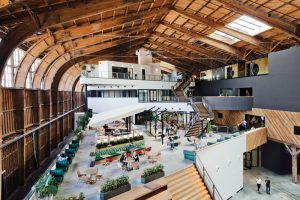The Spruce Goose Project consists of the seismic retrofit of an aircraft hangar (250 feet x 740 feet) with two additional side buildings and the erection of new high-end office space within the hangar. The hangar comprises two 125-foot-wide portal frame arch structures with a central spine running down the middle. Arup worked in collaboration with the architecture firm, ZGF, to rehabilitate and seismically upgrade the existing timber building to current code requirements and to create four new levels of office and film production spaces inside the hangars.
The existing structure was designed and built in the early 1940s using large glue-laminated arches, considered a new technology at the time. The initial seismic design was based on lateral loads equal to 10% of the self-weight of the existing structure. However, the adaptive reuse of the existing facility to a high-end office required the lateral system to be in full compliance with current building standards. Any retrofit methods needed to be benchmarked against the added self-weight to the existing wooden structure. An increase of more than 5% of gravity load would mandate a code-required gravity system retrofit to current building standards. Retrofitting the exiting gravity foundation system consisting of pile caps with wood piles would be very costly and avoided if possible.

The structure is a registered national historic building. Any retrofit measures needed to meet the Army Corps of Engineers requirements of minimal interferences with the visual appearance of the existing building.
The retrofit consisted of two main processes: a) the addition of a code-compliant lateral system and b) the repair of any decay or damage in the 70-year-old wood elements.
Integration of Lateral System
The design team used Grasshopper scripts to define the curved and tapered geometry of the exiting arches in ETABS and evaluate the capacity and behavior of the arches under nonlinear staged loading and deformation load envelopes.
Buckling restraint braced frames (BRBF) were selected as the most efficient solution, and the design team decided to place four BRBF cores spaced equally along the center of the building and connect them to the roof diaphragm. These cores served a dual purpose as the lateral system for the existing building and the new office building inside.
The new office building is a four-story steel frame structure comprised of BRBFs and sits within the existing structure, offset from the walls and roof by a minimum of 20 feet to showcase the beautiful existing timber structure. The BRBF cores in the spine provide lateral resistance to the existing and the new structure in the North/South direction. However, the new and existing structures need additional braces at the perimeter in the longitudinal East/West direction.
The team was able to get the Los Angeles Department of Building and Safety’s approval on the use of multi-tier braced frames (MTBF), which were not codified in the Building Codes at that time. The 55-foot-tall and only 11-foot-wide MTBFs were designed to provide strength and stiffness to work with the flexible timber roof diaphragm. The four MTBFs along each building side in the east-west direction purely serve the lateral stability of the existing building and were located directly in front of the existing sheathed shear walls to minimize visual impact and comply with any visual historic requirements. A merged ETABS model including the new and existing building’s structure was created to analyze the overall behavior of integrating the retrofit scheme with the new building.
Tension tie rods were designed as part of the retrofit scheme and introduced at selected arches at an elevation of 53.5 feet above ground to reduce localized bending overstress in the existing glulam arches due to seismic drift compatibility checks in the N-S direction.
An in-plane steel roof truss was introduced to increase roof diaphragm stiffness and tie the existing glulam arches and the BRBF cores together.
Retrofit of the Glue Laminated Arches
The final and most critical part of the entire retrofit scheme was repairing the existing glulam elements. Many of the existing glulam arches showed signs of small to heavy delamination. Arup evaluated different retrofit and repair strategies such as reinforcing steel plates or plywood sheets, in situ timber gluing, and dowelling options.
Eventually, 17,000 fully threaded and self-tapping screws up to 52 inches in length were chosen to retrofit the original glulam arches. The screws presented a cost-efficient and easy installation solution since pre-drilling was not required due to the self-tapping tip of the screw. This was the most lightweight solution, did not lead to any mandated gravity retrofit, and was the first time these screws were used in Los Angeles.
An overview of each of the delamination locations per arch in elevation was used to streamline the procurement and installation of the screws. In addition, construction documents included retrofit details and schedules corresponding to various delamination classifications. This allowed the contractor to determine the applicable retrofit detail in the field by measuring the delamination depth and using Arup’s schedules.■
Arup was an Outstanding Award Winner for the Google Spruce Goose project in the 2020 Annual Excellence in Structural Engineering Awards Program in the Category – Forensic/Renovation/Retrofit/Rehabilitation Structures > $20M.
